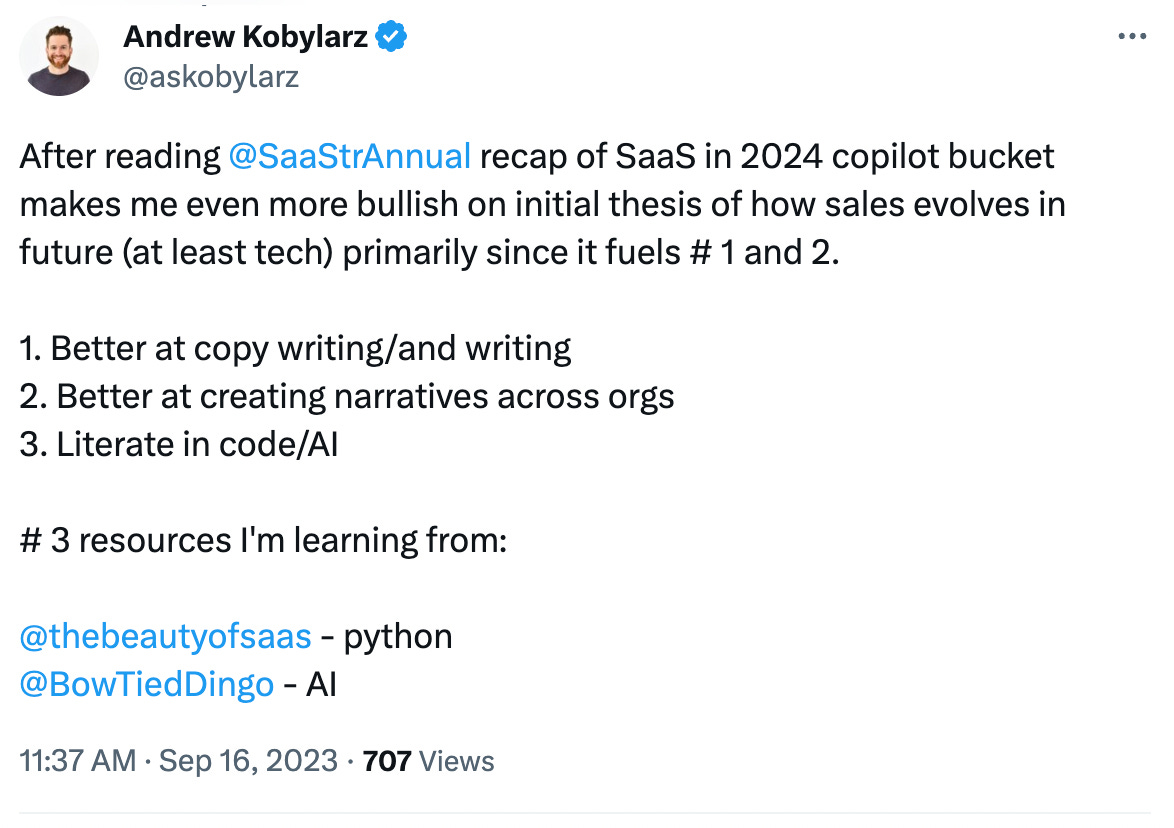GTM is Changing: Are You Ready?
The two things you can do to get ahead in GTM
Credit: Matt Harney, Sapphire Ventures
PS, I’d give Matt a follow. Either on Substack or on X. He provides solid insights on the SaaS industry that’s relevant to any revenue generating role and breaks down the data in an easy to understand way.
“Said differently, only 10% of GTM is spent on quota-carrying reps.” - Matt Harney
This number is down from 30% since 2018. If you’re in a revenue generating role, IC or leadership, this is impactful because despite lowering the investment into individual AE’s, you’re still getting the same overall revenue outputs.
We all know the tech industry headlines are littered with lay offs, downsizing, and revenue/quota targets being missed (by a lot). I see opportunity here. I’ll share more ideas on what you can potentially do, both internally, and what skillsets to focus on as the GTM in tech evolves.
First, let’s unpack this GTM analysis some more:
It’s clear GTM teams have evolved (see infograph below). The IC is a smaller part of the overall revenue function. This has made teams fragmented:
Credit: Sapphire Ventures
The more and more teams that are involved in the GTM function leads to confusion in answering this key question:
Who owns what?
“We’ve gone into this era of hyper specialization which has led to LESS accountability.” - Rajeev Dahm
Rajeev goes onto explain that because there’s not that hub which should be the AE who orchestrates the full GTM flow. Everyone does a little piece of everything which leads to poor customer experience and lack of accountability.
Back in 2018 about 30 - 40% of pipeline was coming from AE’s and today that number is more like 0 - 10%, maybe 15%. The theme is around elevating the AE.
Credit: Will Alred
There’s a couple of things that are important to unpack here. First, if you’re thinking “more work”, I’d invite you to reframe this to more “ownership”. This is a good thing. If you’re an IC, or a leader, and you or your team is not not hitting quota, then the narrative HAS TO BE that we are building, or already have, a fat pipeline. Coupled with lots of activity *and/or* metrics positively indicating we’re getting qualified leads.
What does this mean for you?
I’m going to walk through some things I’m personally doing both from an internal perspective along with what I’m focusing on developing (and I think you should too) as the AE role continues to evolve.
Communicating with and influencing internal stakeholders
Skills to develop as the GTM landscape evolves
Communicating with and influencing internal Stakeholders
Speak with all your GTM stakeholders.
I can’t control everything but I can control that I’m surfacing challenges or productive feedback opportunities I’m seeing. Whether that’s my tech stack, workflow, content for outbound, or even marketing.
Functions outside of direct sales serve to make our roles more productive. Some things I’ve shared:
Discussing content narratives around target ICPs
Content generation to make customer outreach less mentally intensive
Calling out cumbersome workflows that can be fixed via tech team (ie CRM, attribution tracking)
It’s worth noting that this is not a ticket to complain. Provide *critical* feedback. The goal is to be productive. Awareness to challenges is the only way to overcome them.
You might think that this is “extra” work.
Consider this: If you don’t hit quota - it’s over. It’s pretty black and white.
Outside of results, creating narratives to what obstacles you’re facing in your day to day, not only help your team and organization - it helps YOU.
Add to this that its’s much better to be ahead of the conversation and present what you’re doing and what you need, proactively. The alternative is word vomiting the list of challenges you faced after the fact, which are then simply perceived as excuses.
I also need to stress I’m not picking sides - I’m an IC myself. It’s simply matter of fact and perception is everything. Just get ahead of roadblocks if you can from an internal standpoint.
If you’re nervous about being vocal, pressure test these ideas/feedback with your manager. If you’re at a bigger company, communicate with direct line leaders.
Skills to develop as the GTM landscape evolves:
It’s no surprise that AE teams are getting leaner and leaner. You can see the data above, number’s don’t lie. Technology will continue to eat at various aspects of the day to day and sales cycle.
I’m now an even more bullish on the fact that the AE role will need to evolve in not only being a master communicator across both speaking and writing mediums, crafting powerful customer narratives, but also being literate in AI and code.
Resource Links
Beauty of SaaS - Learn Python Basics in 14 Days
*This is a paid sub, there is no affiliate. I’m personally upgrading to a paid subscription because that’s incredible value based on future bets.
*Salesscript AI provides a free trial, there is no affiliate. I’ve also personally upgraded to paid on Dingo’s subscription (Substack) for AI insights.
The last thing I want to leave with you today is this:
Influencing and communicating both internally and externally *is* the sales profession. Deals and commissions are solely a lagging indicator.
Said another way:
"We had an enterprise seller selling to one of the largest corporations in the world. The reason he was able to do a $10/$20 mm deal was because he was able to go out and build bridges within divisions the company didn't even have."
-Karan Singh, Sapphire Ventures
As always, thank you again for reading.
Have a questions or thoughts? Send them to andrew@hackingsales.xyz
See you next Tuesday.
-Andrew K





